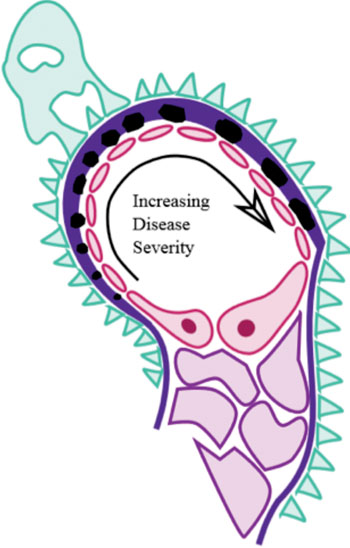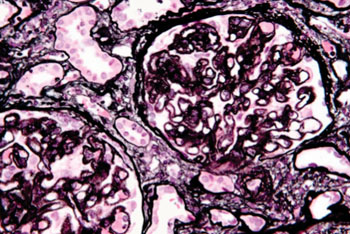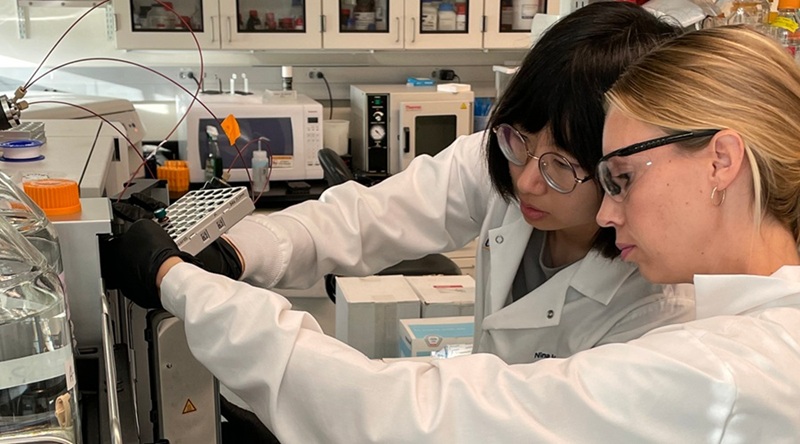Second Protein Identified for Common Kidney Failure
|
By LabMedica International staff writers Posted on 01 Dec 2014 |

Image: Diagram of pathological changes in a glomerulus (visible via electron microscopy) in membranous nephropathy. Black - immune complex; Dark Purple - basement membrane; Pink – endothelium; Green - visceral epithelium; Light Purple - mesangial cells (Photo by M. Komorniczak and Huckfinne, courtesy of Wikimedia).

Image: Very high magnification micrograph of membranous nephropathy (also membranous glomerulonephritis). Jones stain of kidney biopsy. The characteristic feature on light microscopy is basement membrane thickening/spike formation (best seen with silver stains). On electron microscopy, subepithelial deposits are also seen (Photo by Nephron, courtesy of Wikimedia).
An international team of researchers has found a second protein, THSD7A, associated with a common form of kidney failure—the autoimmune “membranous nephropathy” (MN). The discovery is likely to provide an important new biomarker for the disease.
MN occurs when kidney small blood vessels that filter wastes from blood are damaged by circulating autoantibodies. Proteins leak from the damaged blood vessels into the urine. For many people, loss of these proteins eventually leads to nephrotic syndrome. Unchecked, MN can lead to kidney failure or end-stage renal disease (ESRD). Approximately 14% of ESRD is associated with glomerulonephritis, of which MN is a common form.
As the second protein associated with MN and autoimmune response, THSD7A can be used to develop a new blood test. The research team previously discovered phospholipase A2 receptor 1 (PLA2R1) as the protein target of autoantibodies in up to 70% of people suffering from MN. However, the target antigen in the remaining 30% of patients remained unknown. Senior author Gérard Lambeau, PhD, said that the discovery is of THSD7A “and the corresponding anti-THSD7A autoantibodies in a group of about 10% of MN patients who did not have anti-PLA2R1 autoantibodies.” This finding thus identifies a distinct subgroup of MN patients with anti-THSD7A as a likely biomarker.
“The discovery of this second antigen-antibody system in MN will allow clinicians to diagnose this new form of primary (autoimmune) MN and provides a new method to monitor the disease activity in this subgroup of patients,” said co-lead authors Nicola Tomas, MD, and Laurence Beck, MD, PhD. Coauthor Jon Klein, MD, PhD, said, “The team has now found another protein that impacts additional patients with MN. Once a blood test is available, we will have additional tools to follow the response to treatment and possibly reduce the number of kidney biopsies necessary for disease detection.”
“Our discovery of PLA2R1 as the target of autoantibodies energized research and accelerated the pace of discovery in this uncommon but serious cause of kidney disease,” said David Salant, MD, “Hopefully, our current findings will spur further research to identify the target antigen to benefit the remaining 20% of patients with MN.”
“This discovery also represents an excellent example of international collaboration, with the decision to combine the independent discoveries of this target antigen by groups on both sides of the Atlantic into a jointly authored manuscript,” emphasized Dr. Beck and Prof. Rolf Stahl. The team consisted of researchers from France, Germany, and the USA.
The study, by Tomas NM, Beck L, et al., was published online ahead of print November 13, 2014, in the New England Journal of Medicine. It was also presented at the American Society of Nephrology (ASN) (Washington DC, USA) Kidney Week 2014 (November 11–16, Philadelphia, PA, USA; Abstract TH-OR071).
Related Links:
American Society of Nephrology (ASN)
MN occurs when kidney small blood vessels that filter wastes from blood are damaged by circulating autoantibodies. Proteins leak from the damaged blood vessels into the urine. For many people, loss of these proteins eventually leads to nephrotic syndrome. Unchecked, MN can lead to kidney failure or end-stage renal disease (ESRD). Approximately 14% of ESRD is associated with glomerulonephritis, of which MN is a common form.
As the second protein associated with MN and autoimmune response, THSD7A can be used to develop a new blood test. The research team previously discovered phospholipase A2 receptor 1 (PLA2R1) as the protein target of autoantibodies in up to 70% of people suffering from MN. However, the target antigen in the remaining 30% of patients remained unknown. Senior author Gérard Lambeau, PhD, said that the discovery is of THSD7A “and the corresponding anti-THSD7A autoantibodies in a group of about 10% of MN patients who did not have anti-PLA2R1 autoantibodies.” This finding thus identifies a distinct subgroup of MN patients with anti-THSD7A as a likely biomarker.
“The discovery of this second antigen-antibody system in MN will allow clinicians to diagnose this new form of primary (autoimmune) MN and provides a new method to monitor the disease activity in this subgroup of patients,” said co-lead authors Nicola Tomas, MD, and Laurence Beck, MD, PhD. Coauthor Jon Klein, MD, PhD, said, “The team has now found another protein that impacts additional patients with MN. Once a blood test is available, we will have additional tools to follow the response to treatment and possibly reduce the number of kidney biopsies necessary for disease detection.”
“Our discovery of PLA2R1 as the target of autoantibodies energized research and accelerated the pace of discovery in this uncommon but serious cause of kidney disease,” said David Salant, MD, “Hopefully, our current findings will spur further research to identify the target antigen to benefit the remaining 20% of patients with MN.”
“This discovery also represents an excellent example of international collaboration, with the decision to combine the independent discoveries of this target antigen by groups on both sides of the Atlantic into a jointly authored manuscript,” emphasized Dr. Beck and Prof. Rolf Stahl. The team consisted of researchers from France, Germany, and the USA.
The study, by Tomas NM, Beck L, et al., was published online ahead of print November 13, 2014, in the New England Journal of Medicine. It was also presented at the American Society of Nephrology (ASN) (Washington DC, USA) Kidney Week 2014 (November 11–16, Philadelphia, PA, USA; Abstract TH-OR071).
Related Links:
American Society of Nephrology (ASN)
Latest Pathology News
- Rapid Low-Cost Tests Can Prevent Child Deaths from Contaminated Medicinal Syrups
- Tumor Signals in Saliva and Blood Enable Non-Invasive Monitoring of Head and Neck Cancer
- Common Health Issues Can Influence New Blood Tests for Alzheimer’s Disease
- Blood Test Formula Identifies Chronic Liver Disease Patients with Higher Cancer Risk
- Tunable Cell-Sorting Device Holds Potential for Multiple Biomedical Applications
- AI Tool Outperforms Doctors in Spotting Blood Cell Abnormalities
- AI Tool Rapidly Analyzes Complex Cancer Images for Personalized Treatment
- Diagnostic Technology Performs Rapid Biofluid Analysis Using Single Droplet
- Novel Technology Tracks Hidden Cancer Cells Faster
- AI Tool Improves Breast Cancer Detection
- AI Tool Predicts Treatment Success in Rectal Cancer Patients
- Blood Test and Sputum Analysis Predict Acute COPD Exacerbation
- AI Tool to Transform Skin Cancer Detection with Near-Perfect Accuracy
- Unique Immune Signatures Distinguish Rare Autoimmune Condition from Multiple Sclerosis
- Simple Optical Microscopy Method Reveals Hidden Structures in Remarkable Detail
- Hydrogel-Based Technology Isolates Extracellular Vesicles for Early Disease Diagnosis
Channels
Clinical Chemistry
view channel
Online Tool Detects Drug Exposure Directly from Patient Samples
Doctors often rely on patient interviews and medical records to determine what medications a person has taken, but this information is frequently incomplete. People may forget drugs they used, take over-the-counter... Read more
Chemical Imaging Probe Could Track and Treat Prostate Cancer
Prostate cancer remains a leading cause of illness and death among men, with many patients eventually developing resistance to standard hormone-blocking therapies. These drugs often lose effectiveness... Read moreMolecular Diagnostics
view channel
New 15-Minute Hepatitis C Test Paves Way for Same-Day Treatment
Chronic hepatitis C infection affects an estimated 50 million people worldwide and causes around 242,000 deaths each year, largely due to cirrhosis and liver cancer. Although the infection is curable with... Read more
Ovarian Cancer Assay Outperforms Traditional Tests in Early Disease Detection
Globally, ovarian cancer is one of the deadliest cancers affecting women. Traditionally, early diagnosis of ovarian cancer has been challenging. Many ovarian cancers are diagnosed only after they have... Read moreHematology
view channel
MRD Tests Could Predict Survival in Leukemia Patients
Acute myeloid leukemia is an aggressive blood cancer that disrupts normal blood cell production and often relapses even after intensive treatment. Clinicians currently lack early, reliable markers to predict... Read more
Platelet Activity Blood Test in Middle Age Could Identify Early Alzheimer’s Risk
Early detection of Alzheimer’s disease remains one of the biggest unmet needs in neurology, particularly because the biological changes underlying the disorder begin decades before memory symptoms appear.... Read more
Microvesicles Measurement Could Detect Vascular Injury in Sickle Cell Disease Patients
Assessing disease severity in sickle cell disease (SCD) remains challenging, especially when trying to predict hemolysis, vascular injury, and risk of complications such as vaso-occlusive crises.... Read more
ADLM’s New Coagulation Testing Guidance to Improve Care for Patients on Blood Thinners
Direct oral anticoagulants (DOACs) are one of the most common types of blood thinners. Patients take them to prevent a host of complications that could arise from blood clotting, including stroke, deep... Read moreMicrobiology
view channel
Blood-Based Diagnostic Method Could Identify Pediatric LRTIs
Lower-respiratory tract infections (LRTIs) are a leading cause of illness and death worldwide, and pneumonia is the leading infectious cause of death in children under five, claiming the lives of over... Read more
Rapid Diagnostic Test Matches Gold Standard for Sepsis Detection
Sepsis kills 11 million people worldwide every year and generates massive healthcare costs. In the USA and Europe alone, sepsis accounts for USD 100 billion in annual hospitalization expenses.... Read moreRapid POC Tuberculosis Test Provides Results Within 15 Minutes
Tuberculosis remains one of the world’s deadliest infectious diseases, and reducing new cases depends on identifying individuals with latent infection before it progresses. Current diagnostic tools often... Read more
Rapid Assay Identifies Bloodstream Infection Pathogens Directly from Patient Samples
Bloodstream infections in sepsis progress quickly and demand rapid, precise diagnosis. Current blood-culture methods often take one to five days to identify the pathogen, leaving clinicians to treat blindly... Read morePathology
view channel
Rapid Low-Cost Tests Can Prevent Child Deaths from Contaminated Medicinal Syrups
Medicinal syrups contaminated with toxic chemicals have caused the deaths of hundreds of children worldwide, exposing a critical gap in how these products are tested before reaching patients.... Read more
Tumor Signals in Saliva and Blood Enable Non-Invasive Monitoring of Head and Neck Cancer
Head and neck cancers are among the most aggressive malignancies worldwide, with nearly 900,000 new cases diagnosed each year. Monitoring these cancers for recurrence or relapse typically relies on tissue... Read more
Common Health Issues Can Influence New Blood Tests for Alzheimer’s Disease
Blood-based tests for Alzheimer’s disease are transforming diagnosis by offering a simpler alternative to spinal taps and brain imaging. However, many people evaluated at memory clinics also live with... Read more
Blood Test Formula Identifies Chronic Liver Disease Patients with Higher Cancer Risk
Chronic liver disease affects millions worldwide and can progress silently to hepatocellular carcinoma (HCC), one of the deadliest cancers globally. While surveillance guidelines exist for patients with... Read moreTechnology
view channel
Machine Learning Models Diagnose ALS Earlier Through Blood Biomarkers
Amyotrophic lateral sclerosis (ALS) is a rapidly progressive neurodegenerative disease that is notoriously difficult to diagnose in its early stages. Early symptoms often overlap with other neurological... Read more
Artificial Intelligence Model Could Accelerate Rare Disease Diagnosis
Identifying which genetic variants actually cause disease remains one of the biggest challenges in genomic medicine. Each person carries tens of thousands of DNA changes, yet only a few meaningfully alter... Read moreIndustry
view channel
Abbott Acquires Cancer-Screening Company Exact Sciences
Abbott (Abbott Park, IL, USA) has entered into a definitive agreement to acquire Exact Sciences (Madison, WI, USA), enabling it to enter and lead in fast-growing cancer diagnostics segments.... Read more










 (3) (1).png)








